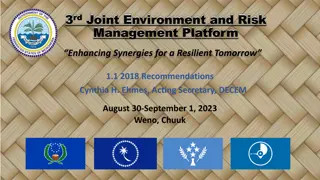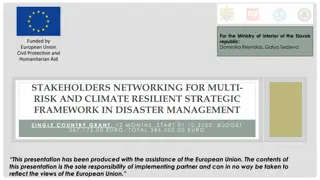Building Disaster Resilient Societies: Progress, Challenges, and the Way Forward
The discourse delves into the current landscape of disaster risk, the status of the Sendai Framework Targets, global DRR challenges identified during the Mid-term Review Process, and the proposed way forward for enhancing disaster resilience. It emphasizes shifting focus towards prevention and risk reduction, strengthening risk governance, integrating risk reduction in sustainable development efforts, and promoting risk-informed and prevention-oriented approaches beyond 2023.
Download Presentation

Please find below an Image/Link to download the presentation.
The content on the website is provided AS IS for your information and personal use only. It may not be sold, licensed, or shared on other websites without obtaining consent from the author. Download presentation by click this link. If you encounter any issues during the download, it is possible that the publisher has removed the file from their server.
E N D
Presentation Transcript
Progress, challenges and way forward Progress, challenges and way forward Building disaster resilient societies
Status of the Sendai Framework Targets at its Mid-Term Target Status Better decreased, excluding COVID-19 Worse - increased by 80% Worse - loss has risen significantly A. Reduce mortality B. Reduce number of affected persons C. Reduce direct economic losses D. Reduce damage to infrastructure and disruption to services Worse - estimated to have doubled Better national strategies increased by 127% to 125 countries Under-reported Low - half of countries lack early warning E. Increase countries with national and local strategies F. Increase international cooperation G. Increase availability of and access to early warning
Global DRR Challenges: Main findings from the Mid-term Review Process Global systemic risks, including increasing climate change impacts and recovery from COVID-19 pandemic Inadequate, often siloed, risk governance and risk management overwhelmed by global catastrophic risks Risk-informed preventative financing lacking, response versus prevention Lack of policy and regulatory imperative / incentives for DRR in private sector decision-making Risk externalized in investments and finance Short-termism Unique challenges for LDCs, LLDCs and SIDS, and persons most at risk not adequately addressed
Way forward o Shift from investing in response to investing in prevention and risk reduction. o Strengthen risk governance architecture multiple authorities and organisations take responsibility for preventing and reducing disaster risk at both national and local levels. o Redress how risk features are treated in the financial system; including to accurately price, account for, and disclose disaster risk. o Integrate risk reduction in sustainable development efforts, climate and humanitarian action, and capitalize on opportunities post-disaster to build back better.
The Opportunity: Promoting risk-informed and prevention-oriented approaches in 2023, and beyond























